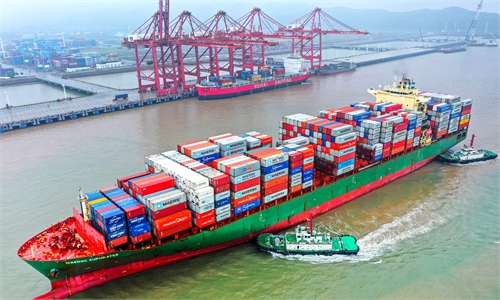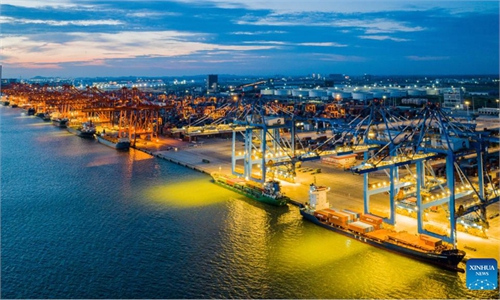China should strive for an average economic growth rate of 5% for 2022-23: official

Photo taken on July 2, 2022 shows the view of a commercial street in Wuhan, central China's Hubei Province. In recent years, Hubei Province has striven to combine its night economy with culture and tourism in innovative ways, thus enhancing the vitality and attraction of nighttime consumption. Photo: Xinhua
China should strive for an average economic growth rate of around 5 percent for 2022 and 2023, as the country's potential growth level is probably between 5 percent and 5.5 percent, Liu Shijin, vice chairman of the Committee on Economic Affairs of the National Committee of the Chinese People's Political Consultative Conference, said on Friday.
Judging from the recent economic trend, it will be difficult to achieve a 5 percent economic growth for the year 2022, said Liu, who made the remarks at the 13th Caixin Summit held simultaneously in Beijing and Singapore from Wednesday to Saturday.
"For the past three years, the actual growth rate of the Chinese economy has been below the potential growth rate. This situation shouldn't continue. Favorable conditions for China's economic recovery are increasing with the recent introduction and implementation of 20 prevention and control measures on further optimizing the response to the COVID-19 outbreak, together with finance policies for real estate sector and policies promoting the development of platform economy," said Liu.
The government should set a growth target of no less than 5 percent in 2023, said Liu.
According to Liu, given the low base of economic growth in 2022, if the impact of the epidemic can be substantially or completely shaken off in the first half of 2023, and all measures to stabilize growth are put in place, the actual growth rate may be even higher.
"We should strive to achieve an average growth rate of around 5 percent in the two years from 2022 to 2023," he noted.
At the beginning of 2022, China set a growth target of around 5.5 percent, but the actual growth rate in the first three quarters was only 3 percent due to unexpected shocks. Liu said considering the recent economic trend, it will be difficult to achieve 5 percent growth in 2022.
Liu also warned that international experience showed that in the process of rising from middle-income country to high-income country, per capita income of around $10,000 is a particularly unstable stage.
"If China's economy fluctuates when its per capita income just exceeded $10,000, it needs to be alarmed. Whether China can cross the threshold of high income as soon as possible still faces challenges," said Liu.
On the proposal for Chinese modernization, Liu said a quantitative indicator is to reach the per capita income level of a moderately developed country by 2035.
From an international perspective, China still needs to achieve three major steps in terms of per capita income by 2035. The first step is to reach $13,200 per capita income and become a high-income country. The second stage is that the per capita income reaches about $20,000 and enters the ranks of developed countries. The third step is for the per capita income to reach $30,000-$40,000, reaching the level of a moderately developed country.
According to Liu's calculation, China's per capita GDP level at the present stage is equivalent to that of Japan in 1975 and Germany in 1971, both of which experienced moderate economic growth and rapid exchange rate appreciation in the following 16 years.
He said that China has entered roughly the same stage of growth, and the relevant experience of Japan and Germany is worth studying and learning from.
China's GDP growth could range from 3.5 percent to 5.0 percent in the scenario of repeated and persistent epidemics, according to a projection made in the China's Fiscal Policy Report 2022 published by the Chinese Academy of Fiscal Sciences on November 9.
In the medium to long term, if China can effectively forestall and defuse public risks, the country can achieve a growth rate of over 5 percent during the 14th Five-Year Plan period (2021-25), read the report, domestic media yicai.com reported.
Global Times



